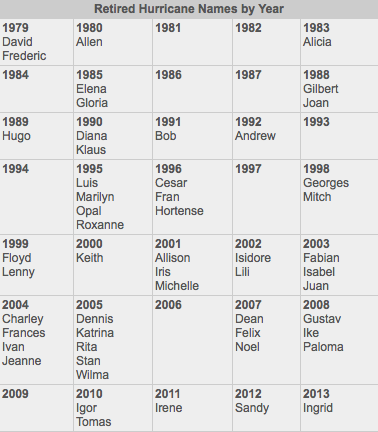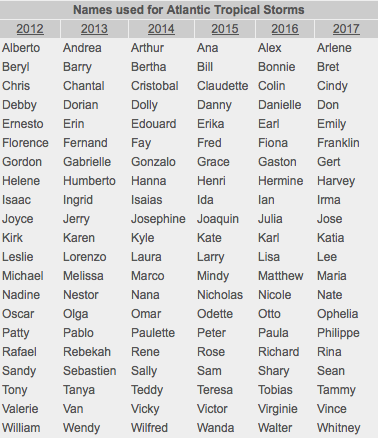Naming Hurricanes: The Past, the Present, and the Future
Hurricane Hugo making landfall at Charleston, SC on September 21, 1989.
Hurricane season is coming to a close next month after a relatively quiet summer. All of the hurricanes in the Atlantic have stayed in the ocean, except Dolly, which hit Mexico. Every hurricane and tropical storm has a name because it’s easier for the public and meteorologists to track their route and location as there may be multiple active hurricanes at once. For this reason, the World Meteorological Organization develops an alphabetical list of names for storms in the Atlantic that reach 39 mph. These names can be repeated every six years, but storms that cause lots of death and destruction are retired and new names are created.
The current list of names was formed in 1979, but hurricanes have been given names for a few hundred years. People living in the Caribbean named storms after saints from the Roman Catholic Church and later, the storms were named based on where they originated. During World War II, hurricanes were given feminine names. However, this process changed again in 1979 when it was decided to alternate between masculine and feminine names for each hurricane. For example, in 2013, Andrea was the first hurricane, then Barry, Chantal, and Dorian. Lastly, tropical storms that form in the Pacific are not given the same names as storms in the Atlantic. Because the storms in the Pacific reach many different countries, separate naming systems are used in the different regions. The National Hurricane Center maintains a list of all the Pacific storm names. For more information on the names of hurricanes, go to http://geology.com/hurricanes/hurricane-names.shtml.
September 21st marks the 25th anniversary of Hurricane Hugo’s landfall on Charleston, SC. The name Hugo was retired in 1989 after it caused $10 billion in damage and killed an estimated 107 people.










